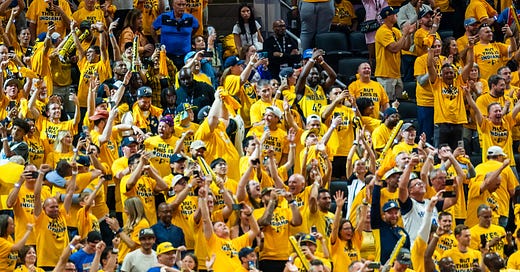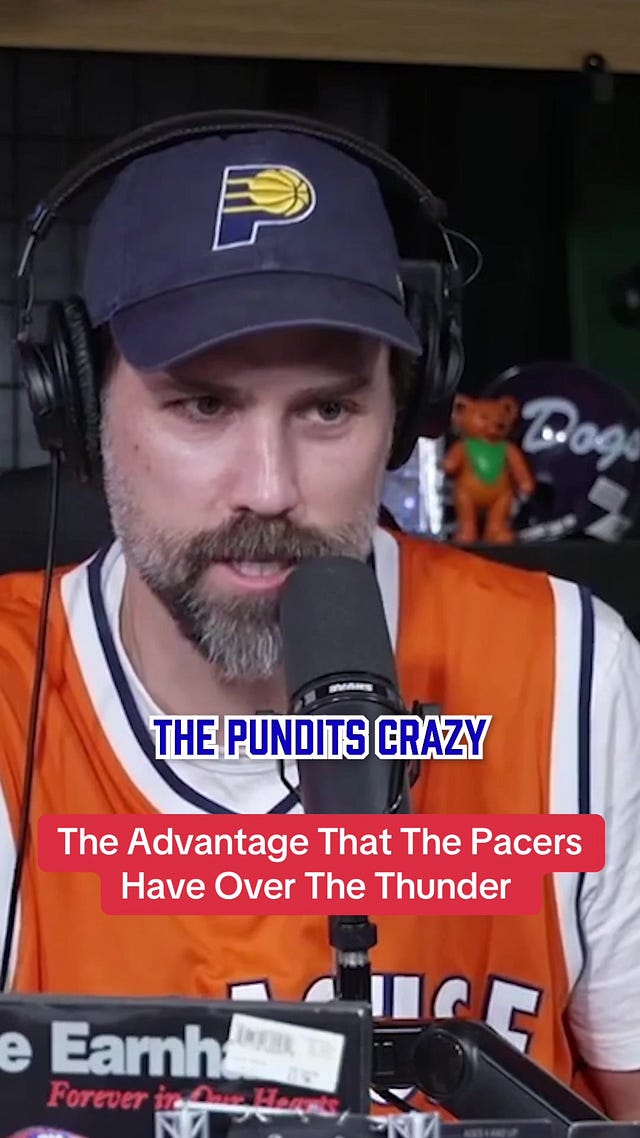Sports Media Can't Comprehend the Indiana Pacers
In a media environment of lazy narratives and quick talking points, the Pacers continue to defy modern logic and cause headaches.
In today’s NBA discourse, teams are often reduced to singular stars. You’re either a team with the guy — a LeBron James, an Anthony Edwards, or a Stephen Curry — or you’re largely ignored, unless you play in a big market.
The Indiana Pacers defy this modern, lazy logic. They don’t neatly fit into the “superteam” narrative or the “rebuild around a generational talent” story. Instead, the Pacers play a refreshing brand of unselfish, team-first basketball that is both rare in the modern era and maddeningly difficult for some media pundits to explain in a single headline or sound bite.
And that is exactly why they are so often ignored. And even as they take a 2-1 lead into Friday night’s Game 4, it’s why so many pundits and fans still refuse to believe that the Pacers are “for real.” We are this far into the playoffs and people are still calling the Pacers run “lucky” and “a fluke.”
On paper, critics argue that the Pacers are overachieving, that they shouldn’t be this good. They don’t have a top-five MVP candidate. Their biggest star, Tyrese Haliburton, is a pass-first point guard more interested in manipulating space than monopolizing the spotlight. Pascal Siakam is a quiet assassin — skilled, efficient and never the loudest voice in the room.
Together, they anchor a team that thrives on movement, unselfishness and offensive harmony. But because neither player consistently dominates the box score like Shai Gilgeous-Alexander, Nikola Jokic or Jayson Tatum, they get doubted.
ESPN’s Stephen A. Smith said as much this week, explaining that his definition of a “superstar” is someone who can go out and score around 30 points on any given night no matter the circumstances. Despite Haliburton’s ascension and heroics this entire postseason, he claims he’s not a superstar simply because he has games where he doesn’t score that much on a regular basis.
But Haliburton’s brilliance is so subtle that pundits often mistake it for inconsistency. His vision, tempo control and basketball IQ are the heartbeat of this team. Without him, the Pacers are a different species entirely.
All of these role players who have had exceptional performances this postseason are able to do so because of how Haliburton plays the point guard position. Every player and every coach on the roster has full confidence in one another. It’s why you saw Haliburton relinquish ball-handling and playmaking duties down the stretch of Game 1 to Andrew Nembhard, who finished with 14 points and six assists, including a late fourth quarter three-pointer in Gilgeous-Alexander’s face.
Siakam, too, gets lost in the shuffle. Despite being an All-NBA talent with a championship pedigree, his move to Indiana barely made a ripple in national conversation. In a league obsessed with flashy relocations to L.A., Miami, or New York, his arrival in Indianapolis was treated as an afterthought.
But his versatility on both ends, his ability to attack mismatches and his calm leadership have been vital to the Pacers' growth. Together, he and Haliburton have forged a quiet chemistry — no drama, no headlines. Just buckets and wins.
This underestimation extends beyond the players to the franchise itself. Indiana basketball has always been about the team over the individual. It’s a state that produced Larry Bird and gave rise to basketball icons at every level, yet somehow remains absent from national conversations unless it’s March and the Hoosiers or Boilermakers are on a run.
Coastal journalists — so often the gatekeepers of basketball narratives — rarely make the trip to Gainbridge Fieldhouse unless a marquee opponent is in town or the Pacers make it to the Finals. The Pacers are viewed as a flyover team in a flyover state.
Even when Indianapolis hosted the NBA All-Star weekend festivities, players and media complained about the location, even though Indianapolis is arguably the best city in America when it comes to hosting major sporting events.
But here’s the thing: the Pacers don’t care. They’re not chasing headlines. They’re chasing good basketball.
They average some of the highest assist numbers in the league, their offense flows like a symphony and they’ve found a rhythm that most teams struggle to defend, as we’ve seen throughout these playoffs.
Unlike many contenders built around isolation-heavy play or heliocentric offensive schemes, Indiana spreads the ball and trusts its depth. Bennedict Mathurin, Aaron Nesmith, Myles Turner, Obi Toppin, T.J. McConnell, Nembhard — these are not household names, but they contribute meaningfully every night.
It's not just the starters; it's the system. As Mark Titus said, the entire team is the star.
Of course, this model doesn’t yield instant gratification. It takes time to appreciate what Indiana is doing — time that hot-take culture rarely affords. To understand the Pacers, you have to watch full games, not just highlights. You have to see how Haliburton leverages pace, how Siakam quietly breaks down defenses, how the second unit doesn't just survive but thrives.
You have to look past the scoreboard and into the seams of the game itself. So when Haliburton calls out media pundits by asking, “what do they really know about basketball?” this is what he means.
Instead of spending time on the lazy “superstar” debate, why don’t pundits spend time actually breaking down basketball? I’ve seen novices on TikTok and YouTube do better basketball breakdowns of these games and what the coaches are doing than anyone on the major platforms have done.
There’s something deeply Midwestern about this team’s approach: no frills, no nonsense, just grit, cohesion and a shared belief that the whole is greater than the sum of its parts. And yet, in a media ecosystem that thrives on stars, scandals, and simplified storylines, that kind of basketball becomes invisible.
The irony is that if this team were in New York, L.A., or even Miami, they’d be hailed as visionaries — a new model of team construction for a new era. But in Indiana, their excellence gets filtered through a lens of indifference. And maybe that’s okay. Maybe the Pacers, like their fans, are content being overlooked — so long as they keep proving everyone wrong.
In the end, the Indiana Pacers are not a glitch in the system. They’re a rebuke of it. They remind us that basketball, at its best, is not about one player dominating the spotlight but about five players sharing the stage. It’s time the rest of the world took notice.






